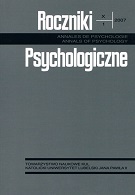Skala Centralności Religijności Stefana Hubera
Centrality of Religiosity Scale
Author(s): Beata ZarzyckaSubject(s): Psychology
Published by: Towarzystwo Naukowe KUL & Katolicki Uniwersytet Lubelski Jana Pawła II
Keywords: religiosity; centrality of religiosity; religiosity measurement
Summary/Abstract: Stefan Huber (2003) developed the Centrality of Religiosity Scale to measure both the global centrality and five dimensions of religiosity as identified by Ch. Glock and Y. Stark (1965, Stark, Glock, 1970): religious beliefs, prayer, religious experience, rite and interests in religious issues. This article presents the Polish version of Huber’s scale (C-15). The scale was translated and backtranslated according to standard requirements. Preliminary indicators of validity and reliability were calculated on the basis of the results obtained from 402 subjects. The results confirmed high discriminative power of the items as well as high homogeneity and stability of the subscales. The global index of centrality was also found to have high psychometric properties. Theoretical validity of the scale was established by means of factor analysis and internal consistency coefficient. The findings confirmed the equivalence of the Polish version of the instrument to the original German version and adequacy to the pre-assumed theoretical model. The convergent and divergent validity was established by means of correlations with other instruments measuring religiosity, i.e. Intensity and Centrality of the Religious Attitude (W. Pr__yna), Religious Crisis Scale (W. Prężyna), Relationship to God Scale (D. Hutsebaut), and Postcritical Beliefs Scale (D. Hutsebaut). The obtained psychometric indexes confirmed high validity and reliability of the presented instrument.
Journal: Roczniki Psychologiczne
- Issue Year: 10/2007
- Issue No: 1
- Page Range: 133-157
- Page Count: 25
- Language: Polish

